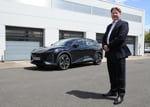Martin Ward, CAP’s manufacturer
relationships manager, scours the globe for the week’s insider fleet intelligence
MONDAY
I’ve been looking back through my note book at scribblings I’ve taken recently, and there seems to be one common theme – the Chinese are coming.
Those manufacturers who have traditionally been at the lower end of the market, selling cars that have not had the quality we have come to expect, have all raised their game and are now producing vehicles of a much higher quality – with fit, finish, technology and style also much improved, but with increased prices, they are no longer bargain basement.
They say that they have had to improve, as they feel that Chinese car manufacturers will replace that end of the market and they don’t seem to want to compete with them.
WEDNESDAY
Discovered a new word today – a word that is apparently used quite extensively within the walls of manufacturers’ secret corridors, but a word I have never heard before.
Nor, it appears, have most other people in the industry.
It’s a word that has got past the security guards from research and development departments and may now be introduced into our world.
This word is ‘haptics’. What does it mean?
It means ‘the touch, feel and sound’ of a component.
Every switch, control, handle and door close has to have the right haptics – touch, feel and sound.
Every manufacturer spends a fortune on ensuring we get the right sound and the right touch from all the parts in their vehicles.
If something doesn’t do the right job it has to be changed, so the human sensory part of our brain likes what it sees and feels.
When you get back into your car, check its haptics – does the handbrake, door handle, heater controls and heated rear window switch make you happy, or do they ‘clunk’ and look, feel and sound cheap? Haptics – the new word we should start using, now that we understand what it means.
THURSDAY
Over to Barcelona to the SEAT plant for a presentation by Erich Schmitt – president of SEAT SA, and a look around some of the new parts of its Spanish factory.
Mr Schmitt is more than passionate about quality – he lives and breathes it.
He told me that he wants SEAT quality to match Audi, and having spent 15 years at Audi, he should know what he is talking about.
He says that the materials are the same, the robots that build the cars are the same, and they use the same tolerances, so there is no reason why the two brands should be different.
Tooling has to be exact and precise from all suppliers for all components.
He has quality meetings every day at 7.30am where any issues are discussed, and a variety of components are inspected by him personally.
If they are not to his standard, the component supplier is summoned to the factory at 6.30am the following day.
SEAT showed us its R&D centre and prototype departments, which were state of the art.
If Mr. Schmitt continues on his crusade to get SEAT up to Audi quality levels then the Spanish manufacturer could see a rise in its worldwide fortune, providing it produces some stylish, sporty cars.















Login to comment
Comments
No comments have been made yet.